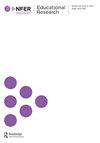Comparing students’ and professionals’ understandings of neighbourhood assets
IF 2.6
3区 教育学
Q1 EDUCATION & EDUCATIONAL RESEARCH
引用次数: 0
Abstract
ABSTRACT Background Internationally, young people experiencing poverty and related disadvantages do least well in school. These inequalities tend to be concentrated in places with high levels of poverty and poor outcomes across multiple domains. Although place-based initiatives are sometimes used by policymakers as a vehicle to improve outcomes, such programmes often fail to engage meaningfully with local resources, further marginalising disadvantaged communities. Purpose This article considers what asset-based approaches, which seek to understand existing resources (assets) in disadvantaged places, might bring to such situations. Focused on a disadvantaged inner-city neighbourhood in England, it explores professionals’ and young people’s understandings of assets through an assets-mapping approach. Method During a two-year study, a university researcher was embedded in a secondary school, and 10 students (aged 13) were trained as co-researchers. Utilising visual mapping methods, they conducted 17 focus groups (45 minutes each) with around 225 of their peers in total. In addition, the researcher conducted 14 semi-structured interviews with a group of local multi-agency professionals and with the co-researchers. Data were analysed thematically. Findings The analysis indicated that professionals and young people understood the neighbourhood’s assets in relation to perceived ‘lived territories’. Professionals described different residential groups as ‘owning’ different geographical ‘territories’, identifying professionally-led institutions as assets that could transcend these. Conversely, young people talked about ‘territories’ primarily in terms of power and control: they identified self-defined social spaces, away from professional scrutiny, as among the neighbourhood’s most valuable assets. Conclusion Exploring the students’ and professionals’ contrasting positions through Giddens’ notion of regionalisation, which distinguishes front spaces (i.e. professional and public-facing) and back spaces (i.e. private and personally developed), suggests that the tangible nature of assets is perhaps less important than the different power relationships at play within them. The study highlights the necessity of working in partnership with young people throughout the development of place-based initiatives.比较学生和专业人士对邻里资产的理解
在国际上,经历贫困和相关不利条件的年轻人在学校表现最差。这些不平等往往集中在多个领域的贫困程度高、结果差的地方。虽然政策制定者有时将基于地方的倡议作为改善结果的工具,但这类项目往往不能有效地利用当地资源,从而进一步边缘化弱势社区。本文考虑了以资产为基础的方法,它试图了解弱势地区的现有资源(资产),可能会给这种情况带来什么。它以英格兰一个弱势的市中心社区为中心,通过资产映射方法探索专业人士和年轻人对资产的理解。方法在为期两年的研究中,将一名大学研究人员嵌入一所中学,并将10名13岁的学生培训为共同研究人员。利用视觉映射方法,他们与225名同龄人进行了17个焦点小组(每个小组45分钟)。此外,研究人员与一组当地多机构专业人员和共同研究人员进行了14次半结构化访谈。数据按主题进行分析。分析表明,专业人士和年轻人理解与感知到的“居住区域”相关的社区资产。专业人士将不同的居民群体描述为“拥有”不同的地理“领土”,并将专业人士领导的机构视为可以超越这些“领土”的资产。相反,年轻人主要从权力和控制的角度来谈论“领土”:他们将自我定义的社会空间,远离专业审查,视为社区最有价值的资产之一。通过吉登斯的区域化概念来探索学生和专业人士的对比立场,该概念区分了前面空间(即专业和面向公众的)和后面空间(即私人和个人开发的),表明资产的有形性质可能不如其中发挥作用的不同权力关系重要。该研究强调了在制定基于地方的倡议的整个过程中与年轻人合作的必要性。
本文章由计算机程序翻译,如有差异,请以英文原文为准。
求助全文
约1分钟内获得全文
求助全文
来源期刊

Educational Research
EDUCATION & EDUCATIONAL RESEARCH-
CiteScore
4.00
自引率
2.90%
发文量
0
期刊介绍:
Educational Research, the journal of the National Foundation for Educational Research (NFER), was established in 1958. Drawing upon research projects in universities and research centres worldwide, it is the leading international forum for informed thinking on issues of contemporary concern in education. The journal is of interest to academics, researchers and those people concerned with mediating research findings to policy makers and practitioners. Educational Research has a broad scope and contains research studies, reviews of research, discussion pieces, short reports and book reviews in all areas of the education field.
 求助内容:
求助内容: 应助结果提醒方式:
应助结果提醒方式:


